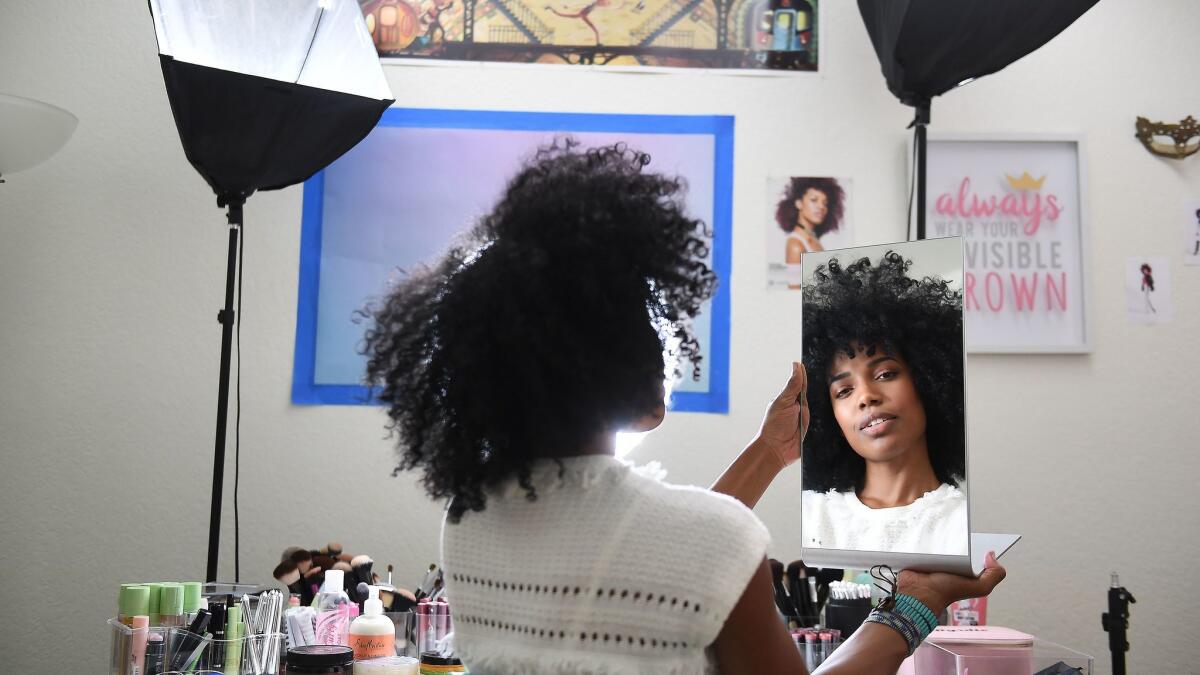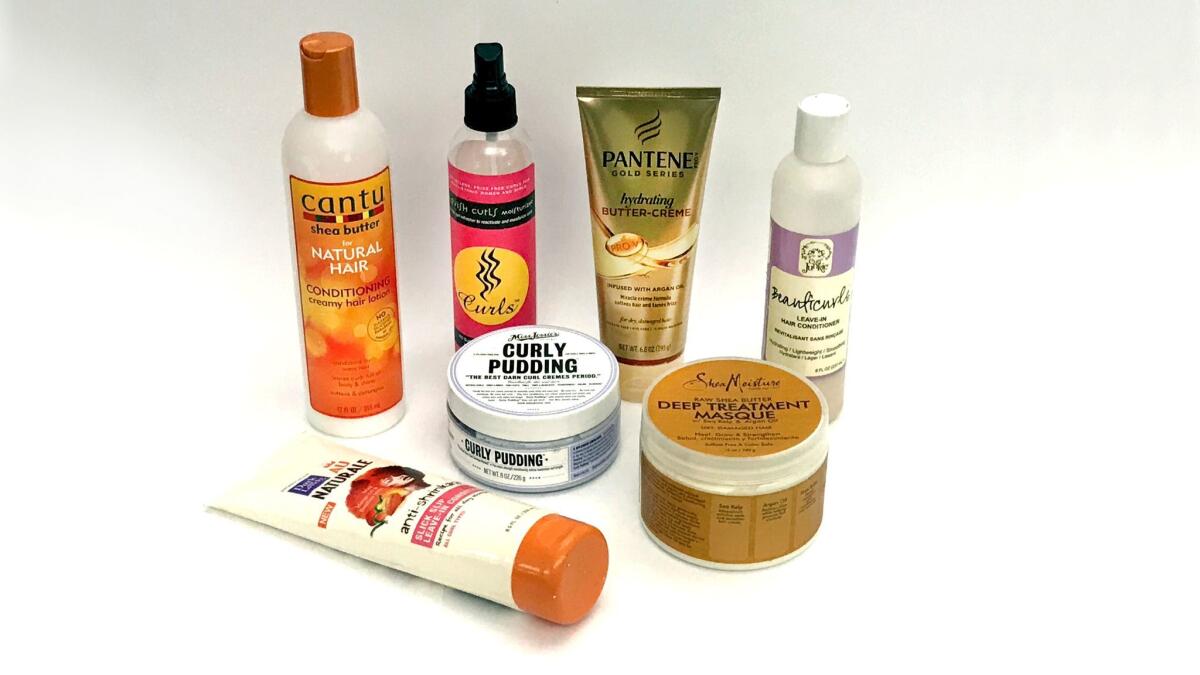Money flowing into the natural hair industry is a blessing and curse for those who built it up

Miko Branch was deep asleep when her sister Titi woke her up to celebrate. After months of experimentation in the kitchen of their Brooklyn brownstone kitchen, she had finally perfected the concoction that would come to be known as Curly Pudding. (A
- Share via
Miko Branch was deep asleep when her sister Titi woke her up to celebrate. After months of experimentation in the kitchen of their Brooklyn brownstone kitchen, she had finally perfected the concoction that would come to be known as Curly Pudding.
It was a major discovery — well worth the early morning wake-up call — because in 2003 there were very few hair products for black women with kinky, curly or wavy hair.
“There was nothing like [Curly Pudding] in the early 2000s,” Miko Branch said. “It was really transformative.”
The product line they would go on to develop, Miss Jessie’s, was one of the pioneering brands in the natural hair industry, a once-grass-roots segment of the beauty world that’s now a hotbed for investment.
In the 1990s and early 2000s, these companies catered to and were largely run by a small community of black women embracing their natural hair. But with 71% of black adults in the U.S. wearing their hair naturally at least once in 2016, according to research firm Mintel, natural hair has now hit the mainstream. And with black consumers spending an estimated $2.56 billion on hair care products in 2016, it’s no surprise others are eager to edge into the market.
Investment from beauty industry giants has helped natural hair products move from specialty stores to the shelves of major retailers such as Target, Wal-Mart and CVS — making it easier for customers to get their hands on what were once niche products.
But it’s also forcing independent black-owned companies to compete with corporations that long ignored the natural hair market, resulting in sometimes uncomfortable changes for customers and business owners alike.
For black women, hair is more than a style — it’s something tangled up in history, politics and race.
Discrimination against black hair can be traced to slavery, when slave owners gave preferential treatment to those with “good hair” — a term still used today to describe black hair that more closely resembles European hair textures. To better assimilate and achieve a higher status in society, black people developed techniques to straighten their hair.
It wasn’t until the civil rights movement that black people began to reclaim their natural hair in droves. However, by the 1990s product offerings for those sporting natural hair remained sparse.
“Back then retailers weren’t bringing in natural brands,” said Richelieu Dennis, chief executive of Sundial Brands, best known for its SheaMoisture line. “They were focused on serving only women with relaxed hair.”
Black hair, which can grow out instead of down, can range from loose waves to tightly packed coils. Because of the hairs’ curl pattern, natural hair products must address unique needs, such as inherent dryness, to promote healthy hair.
With few offerings from major beauty brands, those who wanted to care for natural hair took matters into their own hands, creating products for black customers and an avenue for black entrepreneurship.
Liberian-born Dennis partnered with his college roommate and mother to make hair and skin products inspired by family recipes in 1991. A decade after opening her first salon, Jane Carter launched the Jane Carter Solution product line in 1992. Carol’s Daughter was born out of a Brooklyn kitchen in 1993. Curls, founded in Elk Grove, Calif., and Kinky-Curly, of Los Angeles debuted in 2002 and 2003, respectively. The Branch sisters started Miss Jessie’s in 2004.
Generations of being told in school, work, media and even inside the black community that natural hair was unacceptable had lasting effects. But for black women going against the grain in the 1990s and early 2000s, online forums such as NaturallyCurly.com and Nappturality.com helped foster a sense of pride while spreading the word about nascent businesses, said Shelley Davis, founder of Kinky-Curly. Seeing other black women embrace their hair on YouTube, Facebook and Instagram inspired many to take the plunge.
“It’s always been a community — people sharing and complaining and consoling — that has evolved with different technologies,” Davis said.

As more women went natural, homegrown natural hair operations reaped the benefits. Sales increased and operations expanded. Sundial Brands, which started as a street-vending operation, moved to mass retailers in 2007 and is now worth an estimated $700 million.
“For so long we haven’t had a lot of options, we’ve been sold misinformation and now the tide has changed,” Davis said.
Meanwhile, multinational corporations were left catering to a dying trend: relaxers. According to Mintel, black spending on relaxers fell 30.8% between 2011 and 2016. By 2020, it’s estimated that relaxers will plummet to the smallest segment of the market.
The hair care industry is saturated, said Toya Mitchell, a multicultural analyst at Mintel, with shampoos and conditioners experiencing soft sales. “Companies looking for growth are looking for consumers that are the low hanging fruit,” she said.
Adding natural hair products is an obvious way for big beauty corporations to tap into the more than 24 million black women in the U.S — a market many had previously overlooked.
This has led some multinational beauty brands to build their own natural hair lines. Cantu, developed by AB Brands in 2004, was sold to PDC Brands in 2015. L’Oréal unveiled Au Naturale in 2013. Pantene launched a natural hair line in January developed by a team of black scientists.
Major beauty companies also began investing in and acquiring black-owned natural hair brands.
Carol’s Daughter was sold to L’Oréal in 2014. Namaste Laboratories, known for its Organic Root Stimulator line, was sold to Indian wellness company Dabur for $100 million in 2010. Bain Capital, an investment firm co-founded by onetime presidential candidate Mitt Romney, has a minority stake in Sundial. (Dennis declined to discuss the size of Bain’s stake).
This funding has helped natural hair companies expand. With L’Oréal’s acquisition, Carol’s Daughter reached more than 30,000 stores nationwide. Mitchell estimates that Carol’s Daughter and SheaMoisture are aiming for 45,000 retail outlets.
Despite their increasing influence in the market, major beauty brands acknowledge it will be an uphill battle to win over black customers who feel the industry has neglected their needs.
“We understand that many have the perception that Pantene is not a brand for women with natural hair,” Jodi Allen, vice president of hair care for North America at Procter & Gamble, said in an email.
Such sentiment hasn’t stopped Pantene, Dove and Garnier Fructis from launching “very overt campaigns to black women trying to bring them into the fold,” Mitchell said.

The interest and capital from big beauty has upsides and downsides, said Kashmir Thompson, founder of Delish Condish, a small natural hair product line. “I have mixed feelings because it almost seems kind of culture-vulturish,” she said. But “a part of me feels like it’s about time. I don’t really want to shun it because we should’ve been part of these bigger brands.”
Yet the changing industry has some customers fearing they’re the ones who are being shunned.
The influx of money — and competition — has led some in the natural hair industry to prioritize the most traditional of business goals: growth. With black women making up about 7.5% of the U.S. population, one way to grow sales in the increasingly crowded natural hair sector is to reach new demographics of shoppers.
Some natural hair firms have started targeting a broader audience of multicultural buyers to better compete with corporate giants. But in doing so, they risk alienating their original customer base.
Before its acquisition, Carol’s Daughter signaled a transition with a 2011 ad featuring singer Solange and multiracial models Cassie and Selita Ebanks. “What we’re doing now is moving into a polyethnic space," investor Steve Stoute told Women’s Wear Daily when the campaign was launched.
For some, the ad marked a step away from a movement for black women. "It seems like Carol’s Daughter did what many companies tend to do — feature only lighter-skinned women of color, because they’re considered more palatable to mainstream society," wrote blog Brown Sugar Beauti.
Founder Lisa Price says she knew Carol’s Daughter had the potential to reach a larger demographic than its original largely black and female customer base when she realized the products work for a wide range of hair and skin types.
“We will continue addressing diverse beauty needs and featuring African American women, and all types of women in our advertising — as our Carol’s Daughter family has grown to include real women from around the world,” Price said in an email.
SheaMoisture faced similar backlash for an ad in April. The ad, part of a campaign with dozens of short videos, featured several white women talking about the hair-related struggles they’ve faced — like having red hair. Critics said it minimized the lifetime of discrimination black women face over their hair, affecting their employment prospects, media representations and self-esteem, among other factors.
The blowback was swift and fierce.
“The reason people felt upset is because you feel so close to this brand that you’ve seen grow and you’ve helped build and you’ve spread the word about,” said Patrice Grell Yursik, creator of black beauty website Afrobella. “To see them making decisions that make you feel excluded and that they’re intentionally trying to move on from you as a consumer is hurtful.”
Dennis said the ad did not go through Sundial’s typical process. “We understand that we as a brand have transcended a brand and we are part of our cultural identity and there’s a responsibility that comes with that.”
When asked if they are shifting to a multicultural audience, some brands point to hair type instead of race. “From the beginning, my sister and I were staying focused on texture,” Branch said. “It’s not uncommon for a Jewish woman to have the same afro-texture as a woman with African descent.”
“I’m black,” Davis said. “I made [Kinky-Curly] for my hair type and as time went on, other ethnicities and other demographics have started to use the product which is fine.”
Some customers are denouncing the shifts by brands such as SheaMoisture and Carol’s Daughter — companies that helped kick-start the natural hair movement — and pledging their support to small, independent black-owned companies.
“A lot of these brands ... say they’re listening and in the same breath they try to defend what they do,” said Erin McLaughlin, a 20-year-old from Philadelphia who went natural two years ago.
There’s a reason those with natural hair are concerned, Yursik said. After all, the movement emerged because big beauty companies were ignoring their wants and needs. Who’s to say that won’t happen again?
“I want to see our black brands grow in a way that doesn’t result in alienating us as a consumer base,” she said. “It’s something we’ve seen before.”
Do you have natural hair? We want to hear from you. How do you feel about the natural hair industry? And what do you think about companies shifting toward a more multicultural audience? Tell me your thoughts: makeda.easter@latimes.com.
ALSO
Snap's earnings report puts it up for fresh judging by skeptical investors
Diversity training was supposed to reduce bias at Google. In case of fired engineer, it backfired.
Inside the business of entertainment
The Wide Shot brings you news, analysis and insights on everything from streaming wars to production — and what it all means for the future.
You may occasionally receive promotional content from the Los Angeles Times.








